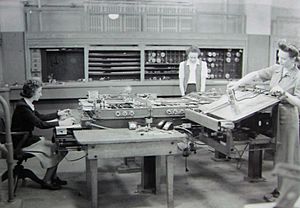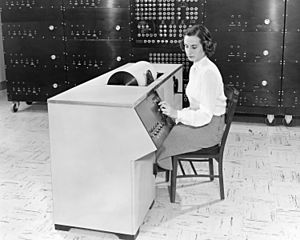Differential analyser facts for kids
The differential analyser was a special kind of analogue computer. It was built using mechanical parts like wheels and discs. Its main job was to solve complex math problems called differential equations. These problems involve finding out how things change over time or space. The differential analyser did this by performing a math operation called integration. It was one of the first advanced computing machines ever used.
At first, these machines couldn't do simple addition. But then, people realized that if you turned the two wheels of a car's rear differential, the main shaft would calculate the average of the two wheels. By adding a simple gear, they could multiply by two, which allowed them to do addition and subtraction. Multiplication was also possible, as it's a special type of integration.
History of Differential Analysers

Scientists started thinking about mechanical ways to solve differential equations a long time ago. In 1836, a French scientist named Gaspard-Gustave de Coriolis designed a device to solve simple differential equations.
The idea for a machine that could solve any type of differential equation came from James Thomson in 1876. He called his device an "integrating machine." His younger brother, Lord Kelvin, also published more ideas about it that same year. Together, their work led to the invention of the differential analyser.
One of the first practical uses of Thomson's ideas was a tide-predicting machine. Lord Kelvin started building this machine in 1872. Later, Thomson's integrating machine was used in a system for aiming naval guns. This system was developed by Arthur Pollen and finished around 1912. It was an early example of an electrically powered mechanical analogue computer. An Italian mathematician named Ernesto Pascal also created similar machines called integraphs around 1914.
The first widely useful differential analyser was built by Harold Locke Hazen and Vannevar Bush at MIT. This happened between 1928 and 1931. It had six mechanical parts that did the integration. Bush first called it a "continuous integraph" in 1928. In 1931, he changed the name to "differential analyzer." He said his machine used the same basic idea as Lord Kelvin's but looked very different. Bush later wrote that he didn't even know about Kelvin's work until his own machine was already working. In 1936, Claude Shannon worked in Bush's lab, helping to run the differential analyser.
Douglas Hartree from Manchester University in England learned about Bush's design. In 1934, he and his student, Arthur Porter, built a small test model. Because it worked well, the university got a full-sized machine in March 1935. This machine had four integrators and was the first of its kind outside the United States. Over the next five years, three more were built in England: at Cambridge University, Queen's University Belfast, and the Royal Aircraft Establishment. One of the parts from Hartree's test model is now in the Science Museum in London.
In Norway, the Oslo Analyzer was finished in 1938. It was based on the MIT machine and had 12 integrators. For four years, it was the largest analyser ever built.
In the United States, more differential analysers were built in the early 1940s. One was at the Ballistic Research Laboratory in Maryland. Another was in the basement of the Moore School of Electrical Engineering at the University of Pennsylvania. This machine was used a lot to calculate tables for artillery guns. It was used before the ENIAC computer was invented. The ENIAC, in many ways, was designed with ideas from the differential analyser. In the early 1940s, Bush tried to build an electrical version, but digital computers being developed elsewhere showed more promise, so his project stopped. In 1947, UCLA got a differential analyser built by General Electric. By 1950, UCLA had three more of these machines. The UCLA differential analyser even appeared in the 1951 movie When Worlds Collide.
Around 1944, a complete differential analyser was developed at Osaka Imperial University in Japan. This machine could calculate how objects move and other problems using mechanical parts. It would then draw graphs on paper with a pen. This machine was later moved to the Tokyo University of Science. It is now displayed at the school’s Museum of Science in Shinjuku Ward. It was restored in 2014 and is one of only two working differential analysers made before the end of World War II.
In Canada, a differential analyser was built at the University of Toronto in 1948 by Beatrice Helen Worsley. However, it seems it wasn't used very much.
Differential analysers were also used for important tasks during World War II. One might have been used to help develop the famous bouncing bomb, which was used to attack German dams. They also helped river control groups calculate soil erosion.
Eventually, newer electronic analogue computers and then digital computers came along. These new computers were much better, and the mechanical differential analyser became outdated.
Using Meccano to Build Analysers

The first differential analyser model built at Manchester University in 1934 by Douglas Hartree and Arthur Porter used many parts from Meccano construction sets. This made the machine much cheaper to build. Even with Meccano parts, it was "accurate enough" to solve many scientific problems.
A similar machine was built by J.B. Bratt at Cambridge University in 1935. This machine is now in the Museum of Transport and Technology (MOTAT) in Auckland, New Zealand. During World War II, this machine was changed to work better and do more. It was used for research on how heat flows, how explosives work, and how electricity travels through wires.
It's thought that about 15 Meccano differential analysers were built around the world. Scientists and researchers used these models for serious work.
See also
 In Spanish: Analizador diferencial para niños
In Spanish: Analizador diferencial para niños



